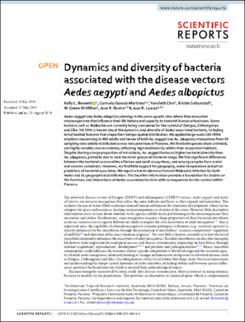| dc.contributor.author | Bennett, Kelly L. | |
| dc.contributor.author | Gómez-Martínez, Carmelo | |
| dc.contributor.author | Chin, Yamileth | |
| dc.contributor.author | Saltonstall, Kristin | |
| dc.contributor.author | McMillan, W. Owen | |
| dc.contributor.author | Rovira, Jose R. | |
| dc.contributor.author | Loaiza, Jose R. | |
| dc.date.accessioned | 2020-07-01T05:00:43Z | |
| dc.date.available | 2020-07-01T05:00:43Z | |
| dc.date.issued | 2019-08-21 | |
| dc.identifier.other | https://doi.org/10.1038/s41598-019-48414-8 | |
| dc.identifier.uri | http://repositorio-indicasat.org.pa/handle/123456789/148 | |
| dc.description | Aedes aegypti and Aedes albopictus develop in the same aquatic sites where they encounter microorganisms that infuence their life history and capacity to transmit human arboviruses. Some bacteria such as Wolbachia are currently being considered for the control of Dengue, Chikungunya and Zika. Yet little is known about the dynamics and diversity of Aedes-associated bacteria, including larval habitat features that shape their tempo-spatial distribution. We applied large-scale 16S rRNA amplicon sequencing to 960 adults and larvae of both Ae. aegypti and Ae. albopictus mosquitoes from 59 sampling sites widely distributed across nine provinces of Panama. We fnd both species share a limited, yet highly variable core microbiota, refecting high stochasticity within their oviposition habitats. Despite sharing a large proportion of microbiota, Ae. aegypti harbours higher bacterial diversity than Ae. albopictus, primarily due to rarer bacterial groups at the larval stage. We fnd signifcant diferences between the bacterial communities of larvae and adult mosquitoes, and among samples from metal and ceramic containers. However, we fnd little support for geography, water temperature and pH as predictors of bacterial associates. We report a low incidence of natural Wolbachia infection for both Aedes and its geographical distribution. This baseline information provides a foundation for studies on the functions and interactions of Aedes-associated bacteria with consequences for bio-control within Panama. | en_US |
| dc.description.abstract | Aedes aegypti and Aedes albopictus develop in the same aquatic sites where they encounter microorganisms that infuence their life history and capacity to transmit human arboviruses. Some bacteria such as Wolbachia are currently being considered for the control of Dengue, Chikungunya and Zika. Yet little is known about the dynamics and diversity of Aedes-associated bacteria, including larval habitat features that shape their tempo-spatial distribution. We applied large-scale 16S rRNA amplicon sequencing to 960 adults and larvae of both Ae. aegypti and Ae. albopictus mosquitoes from 59 sampling sites widely distributed across nine provinces of Panama. We fnd both species share a limited, yet highly variable core microbiota, refecting high stochasticity within their oviposition habitats. Despite sharing a large proportion of microbiota, Ae. aegypti harbours higher bacterial diversity than Ae. albopictus, primarily due to rarer bacterial groups at the larval stage. We fnd signifcant diferences between the bacterial communities of larvae and adult mosquitoes, and among samples from metal and ceramic containers. However, we fnd little support for geography, water temperature and pH as predictors of bacterial associates. We report a low incidence of natural Wolbachia infection for both Aedes and its geographical distribution. This baseline information provides a foundation for studies on the functions and interactions of Aedes-associated bacteria with consequences for bio-control within Panama. | en_US |
| dc.language.iso | eng | en_US |
| dc.rights | http://creativecommons.org/licenses/by/4.0/ | |
| dc.rights | info:eu-repo/semantics/openAccess | |
| dc.subject | Dynamics | en_US |
| dc.subject | diversity of bacteria | en_US |
| dc.subject | disease vectors | en_US |
| dc.subject | Aedes aegypti | en_US |
| dc.subject | Aedes albopictus | en_US |
| dc.title | Dynamics and diversity of bacteria associated with the disease vectors Aedes aegypti and Aedes albopictus | en_US |
| dc.type | info:eu-repo/semantics/article | en_US |
| dc.type | info:eu-repo/semantics/publishedVersion | |

